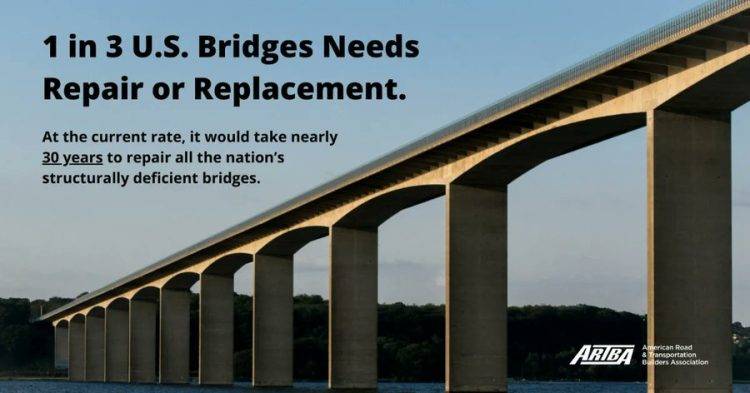Nearly 224,000 U.S. Bridges Need Repair; Placed End-to-End They Would Stretch From L.A. to Maine and Back Again, Latest Analysis of Federal Data Finds

- 43,600 Are “Structurally Deficient” and in Poor Condition. Motorists cross these structures 167.5 million times a day.
- 48 percent of 619,588 Bridges are in Fair Condition.
- Chesapeake Bay Bridge-Tunnel on Route 13, northbound in Northampton, Va., U.S. 60/62 bridge over the Mississippi River connecting Illinois and Missouri, Make List.
- National and State Data Available: www.artbabridgereport.org
WASHINGTON — Nearly 224,000 U.S. bridges need major repair work or should be replaced, according to the American Road & Transportation Builders Association’s (ARTBA) analysis of the recently released U.S. Department of Transportation (DOT) 2021 National Bridge Inventory (NBI) database. That figure represents 36 percent of all U.S. bridges.
If placed end-to-end, these bridges would stretch over 6,100 miles—long enough to crisscross the country from Los Angeles to Portland, Maine and back again, says ARTBA Chief Economist Dr. Alison Premo Black, who conducted the analysis.
The Infrastructure Investment and Jobs Act (IIJA), signed into law last November, provides states with significant new resources to make long overdue infrastructure improvements, including bridge repairs. However, Congress and the Biden administration have yet to release much of the additional funding because they have not enacted a full-year FY 2022 transportation appropriations law at the IIJA-authorized investment levels. The current continuing resolution, which holds spending for most federal surface transportation programs flat at FY 2021 levels, ends Feb. 18.
“The longer it takes to bridge the political divide on the FY 2022 spending bills, the longer it will take for transportation improvements to get started,” ARTBA President & CEO Dave Bauer said. “We urge Congress to act forthwith so that the American people can begin to realize the benefits of the historic investments in the bipartisan infrastructure law.”
Based on average repair and replacement cost data published by the Federal Highway Administration (FHWA) and submitted by bridge owners (typically state DOTs), ARTBA estimates the cost of identified repairs for all 224,000 bridges, including the 43,578 structurally deficient, is $260 billion.
Among other findings in the report:
- 78,800 bridges should be replaced
- The number of structurally deficient bridges was down by 1,445 compared to 2020. At current pace, it would take 30 years to repair them all.
- Almost half of the 619,588 U.S. bridges—48 percent—are rated in fair condition. This means that the bridge shows evidence of minor deterioration or minor cracks. The number of bridges in fair condition grew by 2,916 in 2021, reaching 297,888 structures.
- States with the largest number of bridges in poor condition: Iowa (4,504), Pennsylvania (3,198), Illinois (2,405), Oklahoma (2,296), Missouri (2,218), New York (1,672), Louisiana (1,631), California (1,493), West Virginia (1,490), and Ohio (1,334)
- States and territories with the most bridges in poor condition as a percentage of their total bridge inventory: West Virginia (20 percent), Iowa (19 percent), Rhode Island (17.5 percent), South Dakota (17.3 percent), Pennsylvania (13.8 percent), Louisiana (12.7 percent), Maine (12.6 percent), Puerto Rico (12.1 percent), North Dakota (11.2 percent), and Michigan (11 percent).
Watch this short video summary of the report with Dr. Black.
Established in 1902 and with more than 8,000 public and private sector members, the Washington, D.C.-based ARTBA advocates for strong investment in transportation infrastructure to meet the public and business community demand for safe and efficient travel.


